 Gurteen Stone Circle & Boulder-Burial are beside a farm track, just a short distance from the public road.
This is basically an eleven stone circle with one stone fallen but outside the portals are another pair of stones set radially to emphasise the entrance; one leaning, one fallen.
A boulder-burial, probably a later addition, occupies the centre.
Gurteen Stone Circle & Boulder-Burial are beside a farm track, just a short distance from the public road.
This is basically an eleven stone circle with one stone fallen but outside the portals are another pair of stones set radially to emphasise the entrance; one leaning, one fallen.
A boulder-burial, probably a later addition, occupies the centre.
South [Pic] is on the right side of the local hilltop, which is a very sensitive indicator for the winter solstice. North is across the valley, well to the right of the high point, at a bit of a break in the slope [Pic].
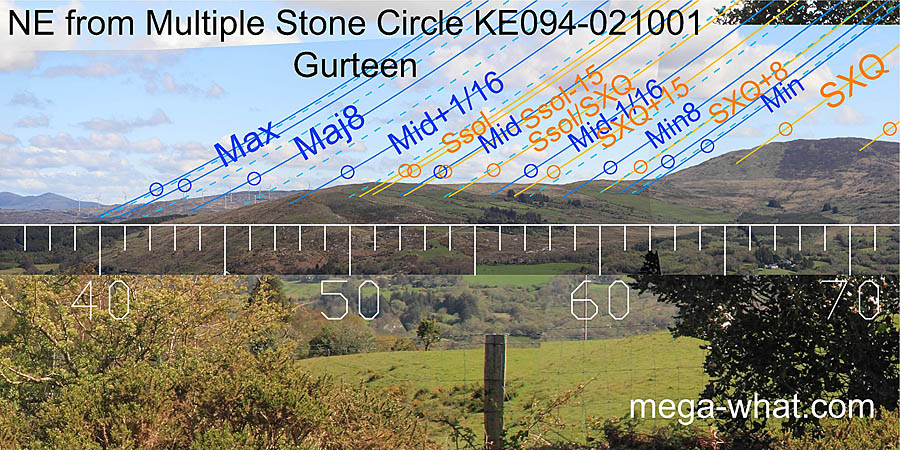 To the north-east, major standstillsLunistice positions vary cyclically over an 18.6 year period but are fairly static for more than a year at either end of the range
rise from a dip, minor ones from a step. The solstice is on a top, summer cross-quarters are at the left end of one.
To the north-east, major standstillsLunistice positions vary cyclically over an 18.6 year period but are fairly static for more than a year at either end of the range
rise from a dip, minor ones from a step. The solstice is on a top, summer cross-quarters are at the left end of one.
The circle axis is well beyond the lunar limit in this direction [Pic].
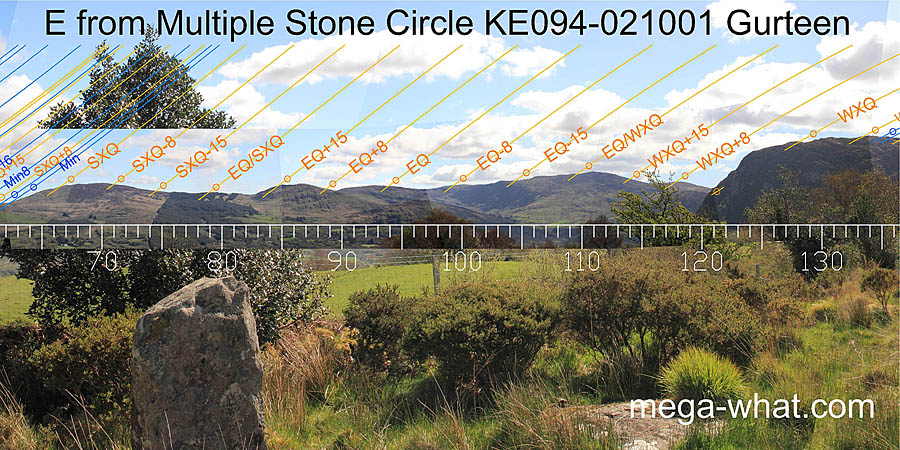 Eastwards, the equinox is indicated by a hilltop and the month centred on it is well marked. Summer and winter cross-quarters are at the left end of hilltops.
The midpoints between them and the equinox are also usefully marked.
Eastwards, the equinox is indicated by a hilltop and the month centred on it is well marked. Summer and winter cross-quarters are at the left end of hilltops.
The midpoints between them and the equinox are also usefully marked.
A tall, thin stone on this side and a matched pair on the other make an axial indicator for the summer cross-quarters [Pic].
 Winter cross-quarters and minor standstillsLunistice positions vary cyclically over an 18.6 year period but are fairly static for more than a year at either end of the range
are both on the south-eastern hilltop though the highest point marks a quarter-month.
To either side, basal steps make high precision indicators for the cross-quarters and lunar major eighths.
Winter cross-quarters and minor standstillsLunistice positions vary cyclically over an 18.6 year period but are fairly static for more than a year at either end of the range
are both on the south-eastern hilltop though the highest point marks a quarter-month.
To either side, basal steps make high precision indicators for the cross-quarters and lunar major eighths.
A wide, flat-topped stone makes an axial indicator in this direction for the space between winter cross-quarters and minor standstillLunistice positions vary cyclically over an 18.6 year period but are fairly static for more than a year at either end of the range [Pic] but the reverse is beyond the north-west lunar limit [Pic].
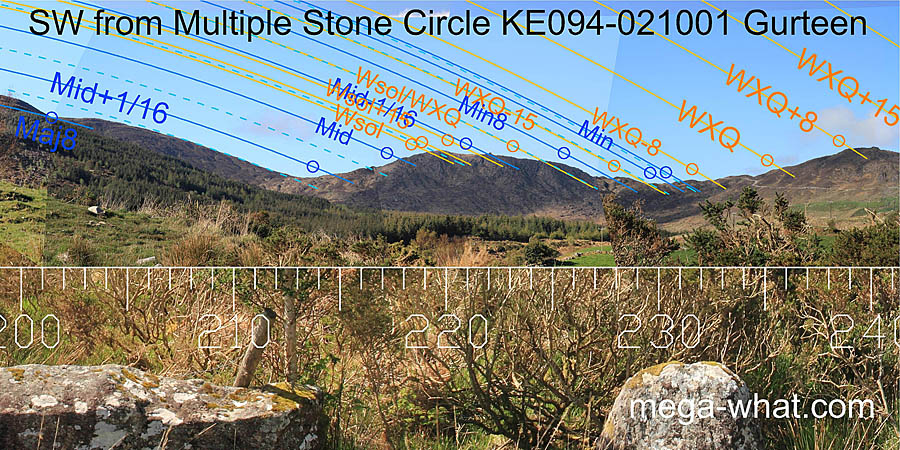 To the south-west, winter solstice is on a hilltop. Minor standstillsLunistice positions vary cyclically over an 18.6 year period but are fairly static for more than a year at either end of the range
are in a dip and an intersect notch makes another high precision indicator for the major eighth, mirroring the south-east.
Due to the high horizon, southern lunisticesLunistices are the most northerly and southerly moons of the month. The lunar equivalent of solstices - more.
are not visible at all for about four and a half years at the major end of the cycle.
To the south-west, winter solstice is on a hilltop. Minor standstillsLunistice positions vary cyclically over an 18.6 year period but are fairly static for more than a year at either end of the range
are in a dip and an intersect notch makes another high precision indicator for the major eighth, mirroring the south-east.
Due to the high horizon, southern lunisticesLunistices are the most northerly and southerly moons of the month. The lunar equivalent of solstices - more.
are not visible at all for about four and a half years at the major end of the cycle.
The circle axis indicates lunisticeLunistices are the most northerly and southerly moons of the month. The lunar equivalent of solstices - more. sets, particularly the major eighth [Pic]. The boulder axis is a bit more to the west but the difference is not obviously significant [Pic].
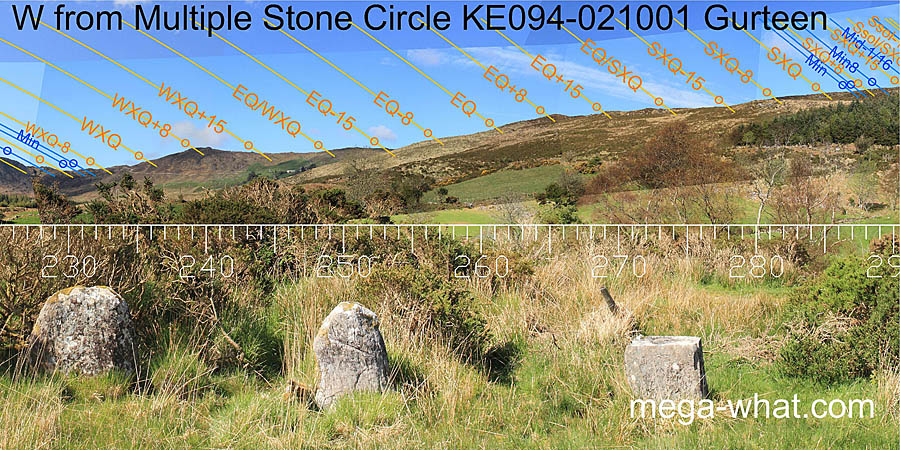 Westwards, the equinox, winter cross-quarters and equinox / cross-quarter midpoints all have reasonable markers but the quarter and half months get better ones.
Westwards, the equinox, winter cross-quarters and equinox / cross-quarter midpoints all have reasonable markers but the quarter and half months get better ones.
A matched pair of stones on this side and a tall thin one on the other make an axial indicator for the equinox / winter cross-quarter midpoint [Pic].
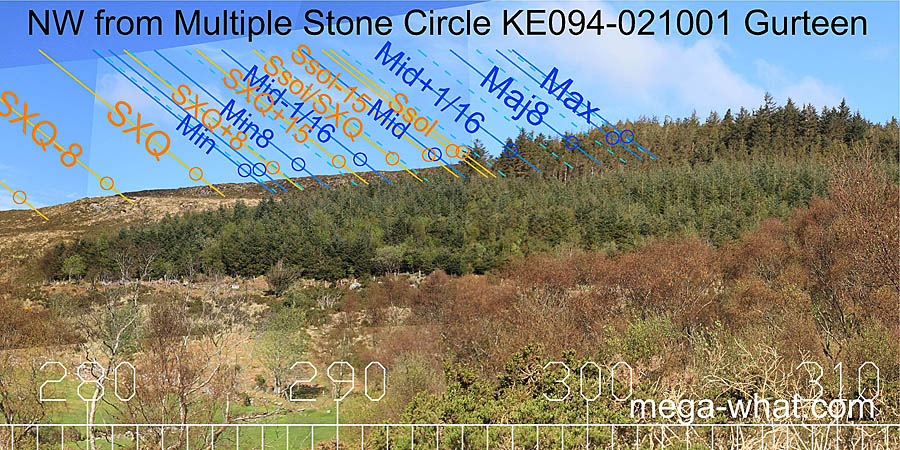 North-western lunisticesLunistices are the most northerly and southerly moons of the month. The lunar equivalent of solstices - more.
fail to reach the hilltop. Minor standstillsLunistice positions vary cyclically over an 18.6 year period but are fairly static for more than a year at either end of the range
are indicated by a small notch. The step that begins the sequence is a half-month before Bealtaine, after Lughnasadh.
North-western lunisticesLunistices are the most northerly and southerly moons of the month. The lunar equivalent of solstices - more.
fail to reach the hilltop. Minor standstillsLunistice positions vary cyclically over an 18.6 year period but are fairly static for more than a year at either end of the range
are indicated by a small notch. The step that begins the sequence is a half-month before Bealtaine, after Lughnasadh.
There are some more megalithic sites in the general area but the nearest surveyed ones are:
- Derrynafinchin Stone Circle is over the hills to the south, c.9km @ 150°
- Uragh Five Stone Circle is along Kenmare Bay to the west, c.19km @ 249°
- Gortanimill Stone Circle is over the hills to the east, c.21km @ 77°
References
- Archaeological Survey of Ireland, record details. www.archaeology.ie/archaeological-survey-ireland
- BYRNE, ELIZABETH et al. 2009 Archaeological Inventory of County Kerry, Volume I: South-West Kerry. Dublin: Stationary Office. p16, no.64.
- Ó'NUALLÁIN, SEÁN 1984 A Survey of Stone Circles in Cork and Kerry. Proceedings of the Royal Irish Academy 84c:1-77, p27, no.43.
- Ó'NUALLÁIN, SEÁN 1978 Boulder-Burials. Proceedings of the Royal Irish Academy 78c:75-114, p97, no.37.
- RUGGLES, C.L.N. 1999 Astronomy in Prehistoric Britain and Ireland. Newhaven & London: Yale University Press. No.ASC15.
